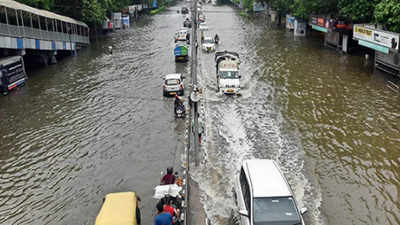- News
- City News
- delhi News
- Brace for more rain as IMD issues three-day 'Orange' alert for Delhi
Trending
Brace for more rain as IMD issues three-day 'Orange' alert for Delhi
The city faced high humidity levels with no rain. IMD issued an orange alert for heavy rain. Safdarjung recorded a maximum temperature of 37.1 degrees Celsius. June saw extreme heat and rain events, leading to a high heat index. Noida highlighted challenges due to heavy rainfall, stressing improved monsoon preparedness.

The India Meteorological Department (IMD) has, however, issued an orange alert for heavy rain for the next three days — Monday to Wednesday.
On Sunday, the humidity oscillated between 60% and 97% throughout the day, with bright sunshine in a few places, making it uncomfortable to be outdoors for too long.The IMD expects the humidity to remain high throughout the week.
Experts said, the monsoon trough line remained away, towards the south of the city.
“The monsoon is towards the south of Delhi and is expected to move northwards on Monday. It will pass over Delhi and thus there are chances of good rain over the city on Monday and Tuesday. It will thereafter pass over towards the Himalayan foothills,” said Mahesh Palawat, vice president, climate change and meteorology, Skymet.
Meanwhile, the city's base station, Safdarjung, recorded a maximum temperature of 37.1 degrees Celsius, the season’s normal, against 35.6 degrees Celsius a day earlier. The minimum temperature was 27 degrees Celsius, a notch below normal, against 28 degrees Celsius a day earlier.
June recorded extreme heat and extreme rain events. The average monthly minimum temperature was 29.8 degrees Celsius, which is 1.9 degrees Celsius higher than the long-period average for June at 27.7 degrees Celsius. This figure is the highest for the month since 2012 (30.6 degrees Celsius).
Despite normal or below normal temperatures, high humidity levels also kept the feel-like temperature or heat index high. The heat index on Sunday was marked at 51 degrees Celsius.
The net monthly rainfall for June was 243.4 mm (228% excess rainfall), the highest since 1936 for the month. Of this, 228.1 mm was recorded on Friday, the day monsoon arrived in the city.
In June 1936, the city recorded 415.8 mm of rainfall. In June 1933, the city recorded 399 mm of rainfall.
Meanwhile, the IMD had forecast heavy rain for the city with gusty winds reaching 30-40 kmph. On Monday, the maximum and minimum temperatures are likely to drop and hover around 33 and 26 degrees Celsius, respectively.
We also published the following articles recently
IMD says Delhi records heaviest June rainfall since 1936
The heavy rainfall in Delhi-NCR resulted in severe traffic jams and waterlogging, exposing infrastructure deficiencies. Despite prior assurances, major intersections faced closures and disruptions. Noida also experienced challenges, emphasizing the need for improved monsoon preparedness. The rainfall lowered the temperature, providing relief from intense heat.
The heavy rainfall in Delhi-NCR resulted in severe traffic jams and waterlogging, exposing infrastructure deficiencies. Despite prior assurances, major intersections faced closures and disruptions. Noida also experienced challenges, emphasizing the need for improved monsoon preparedness. The rainfall lowered the temperature, providing relief from intense heat.
Monsoon Arrives: Heavy Rains Lash City
The southwest monsoon brought heavy rain and thunder showers to Bhopal, with early onset this year. Weather systems like a western disturbance and cyclonic circulation led to showers in multiple state locations. Temperature variations were observed with weather warnings issued for various districts. Monsoon progress indicated further expansion into different states with a defined northern limit.
The southwest monsoon brought heavy rain and thunder showers to Bhopal, with early onset this year. Weather systems like a western disturbance and cyclonic circulation led to showers in multiple state locations. Temperature variations were observed with weather warnings issued for various districts. Monsoon progress indicated further expansion into different states with a defined northern limit.
June rainfall falls short of monthly average despite early monsoon onset
Weather enthusiasts monitor the uncertain monsoon season in Mumbai, hoping for consistent rain to meet the city's water needs. Despite early hopes for a bountiful season, below-normal June rainfall has dampened expectations. Residents look to the seven lakes for water replenishment, while forecasts guide preparations for potential heavy rainfall.
Weather enthusiasts monitor the uncertain monsoon season in Mumbai, hoping for consistent rain to meet the city's water needs. Despite early hopes for a bountiful season, below-normal June rainfall has dampened expectations. Residents look to the seven lakes for water replenishment, while forecasts guide preparations for potential heavy rainfall.
End of Article
FOLLOW US ON SOCIAL MEDIA










